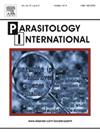马bertrami Sarcocystis (syn. s.f ayeri)(顶复合体:真球胞目:肌囊科)cox1和LSU rDNA序列的分子多样性
IF 1.9
4区 医学
Q3 PARASITOLOGY
引用次数: 0
摘要
食用被肉囊菌污染的生马肉引起的食物中毒是一个重大的公共卫生问题。马肉中有两种形态的肌囊肿,其特征是直立和折叠的绒毛突起,分别被鉴定为费耶氏肌囊肿和贝特拉米肌囊肿。然而,最近对核糖体RNA基因(rDNA)和线粒体细胞色素c氧化酶亚基I基因(cox1)的分子研究表明,使用有限数量的标本,这两种形态之间存在同种关系。为了进一步探索马科动物肌囊的遗传多样性,我们分析了150匹马(分别为加拿大和法国进口马76匹和法国进口马41匹,日本饲养马33匹)肉中提取的肌囊的cox1和大亚基rDNA序列。分别在加拿大、法国和日本的71匹、2匹和3匹马的肌肉中检测到肌囊。58个结节囊肿进行了cox1和LSU rDNA测序。新获得的cox1序列(n = 53)和从GenBank检索到的标记为S. bertrami、S. fayeri和S. asinus的序列(n = 53)表现出同种关系。尽管没有观察到个体内的变异,但在不同的肌囊中,甚至在单个宿主动物中,也观察到cox1序列的个体间变异。然而,核嵌入线粒体DNA (NUMT: cox1假基因)序列是使用不适当的技术使用某些引物获得的。来自54个肌囊的211个克隆序列的LSU rDNA在个体间和个体内表现出强大的变异,表明在海苔中存在显著的基因组内rRNA阵列嵌合。这些发现证实了经典定义种的同一性,没有地理亚群。本文章由计算机程序翻译,如有差异,请以英文原文为准。

Molecular diversity of cox1 and LSU rDNA sequences of Sarcocystis bertrami (syn. S. fayeri) (Apicomplexa: Eucoccidiorida: Sarcocystidae) in horses
Food poisoning caused by consuming raw horsemeat contaminated with Sarcocystis is a significant public health concern. Two morphotypes of sarcocysts in horsemeat, characterized by upright and folded villar protrusions, are typically identified as Sarcocystis fayeri and S. bertrami, respectively. However, recent molecular studies focusing on the ribosomal RNA gene (rDNA) and mitochondrial cytochrome c oxidase subunit I gene (cox1) have indicated a conspecific relationship between these two morphotypes using a limited number of specimens. To explore further genetic diversity in equid sarcocysts, cox1 and large-subunit (LSU) rDNA sequences were analyzed in sarcocysts extracted from horsemeat inspected from 150 horses (76 and 41 horses imported from Canada and France, respectively, and 33 horses reared in Japan). Sarcocysts were detected in the muscles of 71, 2, and 3 horses from Canada, France, and Japan, respectively. Fifty-eight sarcocysts underwent cox1 and the LSU rDNA sequencing. Newly obtained cox1 sequences (n = 53) and sequences labeled as equid S. bertrami, S. fayeri and S. asinus retrieved from GenBank (n = 53) exhibited conspecific relationships. Inter-individual variation in cox1 sequences was observed among various sarcocysts, even within a single host animal, although no intra-individual variation was observed. However, nuclear-embedded mitochondrial DNA (NUMT: cox1 pseudogene) sequences were obtained using inappropriate techniques using certain primers. The LSU rDNA of sarcocysts (211 cloned sequences from 54 sarcocysts) exhibited inter-individual and robust intra-individual variations, indicating significant intragenomic rRNA array mosaicism in S. bertrami. These findings confirmed the conspecificity of classically defined species without geographical subpopulations.
求助全文
通过发布文献求助,成功后即可免费获取论文全文。
去求助
来源期刊

Parasitology International
医学-寄生虫学
CiteScore
4.00
自引率
10.50%
发文量
140
审稿时长
61 days
期刊介绍:
Parasitology International provides a medium for rapid, carefully reviewed publications in the field of human and animal parasitology. Original papers, rapid communications, and original case reports from all geographical areas and covering all parasitological disciplines, including structure, immunology, cell biology, biochemistry, molecular biology, and systematics, may be submitted. Reviews on recent developments are invited regularly, but suggestions in this respect are welcome. Letters to the Editor commenting on any aspect of the Journal are also welcome.
 求助内容:
求助内容: 应助结果提醒方式:
应助结果提醒方式:


